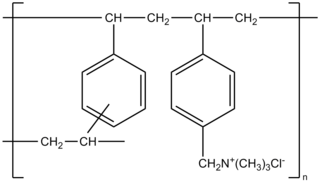
Mercurial diuretics are a form of renal diuretic [1] containing mercury.
Contents
Although previously widely used, they have largely been superseded by safer diuretics such as thiazides, and are now rarely used.

Mercurial diuretics are a form of renal diuretic [1] containing mercury.
Although previously widely used, they have largely been superseded by safer diuretics such as thiazides, and are now rarely used.
Inorganic mercury compounds, such as mercury(I)chloride (calomel), were found to have diuretic properties when they were used to treat syphilis. [2] Proposed use of these compounds date back at least to the 16th century, shortly after the beginning of the syphilis epidemic in 1497 following Columbus' return to Europe. [3]
Mercurial diuretics cause diuresis by reducing the reabsorption of sodium in the ascending loop of Henle, thus causing more water being delivered to the distal convoluted tubule. Unfortunately, earlier physicians misconstrued hallmark symptoms of mercury poisoning such as excessive salivation as signs of mercury's efficacy until the early 1960s, when the use of mercurial diuretics was halted in medicine.
Due to the idiosyncratic nature of mercury toxicity, the risk of severe disease and sudden death are unpredictable and frequently show no warning signs. Physicians during the 20th century believed that a fever/rash complex suggested the risk of severe side effects for the next upcoming doses if treatment was not halted. Warkany and Hubbard noted in their seminal 1953 paper establishing mercury as the cause of infantile acrodynia that "... in modern times the capricious behavior of mercurial diuretics has been rather disturbing to those who use them frequently. Thousands of injections are given without untoward effects but occasionally a therapeutic dose results in sudden death. Only rarely is this caused by the first dose. More often the patient tolerates several—in one case 164—doses before the fatal reaction occurs. The mechanism of these reactions is not clear: they can neither be explained nor predicted; yet they cannot be denied."
After finding associations between mercurial diuretics and "mercurial" nephrotic syndrome, in addition to the sharp decline in infantile acrodynia cases after the late 1950s following the removal of many sources of childhood mercury exposure, the dangers of mercurial diuretics were realized. This led to the discontinuation of mercurial diuretics in favor of far less toxic and far more effective diuretics. This is similar to the fashion in which penicillin quickly replaced arsenic and mercury as the main antibiotic used in the treatment of syphilis for both children and adults.
Some common organic mercurials:

Thiomersal (INN), or thimerosal, also sold under the name merthiolate is an organomercury compound. It is a well-established antiseptic and antifungal agent.

Allopurinol is a medication used to decrease high blood uric acid levels. It is specifically used to prevent gout, prevent specific types of kidney stones and for the high uric acid levels that can occur with chemotherapy. It is taken orally or intravenously.

Digitoxin is a cardiac glycoside used for the treatment of heart failure and certain kinds of heart arrhythmia. It is a phytosteroid and is similar in structure and effects to digoxin, though the effects are longer-lasting. Unlike digoxin, which is eliminated from the body via the kidneys, it is eliminated via the liver, and so can be used in patients with poor or erratic kidney function. While several controlled trials have shown digoxin to be effective in a proportion of patients treated for heart failure, the evidence base for digitoxin is not as strong, although it is presumed to be similarly effective.

Mercury poisoning is a type of metal poisoning due to exposure to mercury. Symptoms depend upon the type, dose, method, and duration of exposure. They may include muscle weakness, poor coordination, numbness in the hands and feet, skin rashes, anxiety, memory problems, trouble speaking, trouble hearing, or trouble seeing. High-level exposure to methylmercury is known as Minamata disease. Methylmercury exposure in children may result in acrodynia in which the skin becomes pink and peels. Long-term complications may include kidney problems and decreased intelligence. The effects of long-term low-dose exposure to methylmercury are unclear.

Mercury(II) chloride (or mercury bichloride, mercury dichloride), historically also known as sulema or corrosive sublimate, is the inorganic chemical compound of mercury and chlorine with the formula HgCl2, used as a laboratory reagent. It is a white crystalline solid and a molecular compound that is very toxic to humans. Once used as a treatment for syphilis, it is no longer used for medicinal purposes because of mercury toxicity and the availability of superior treatments.

Uremia is the condition of having high levels of urea in the blood. Urea is one of the primary components of urine. It can be defined as an excess in the blood of amino acid and protein metabolism end products, such as urea and creatinine, which would normally be excreted in the urine. Uremic syndrome can be defined as the terminal clinical manifestation of kidney failure. It is the signs, symptoms and results from laboratory tests which result from inadequate excretory, regulatory, and endocrine function of the kidneys. Both uremia and uremic syndrome have been used interchangeably to denote a very high plasma urea concentration that is the result of renal failure. The former denotation will be used for the rest of the article.

Furosemide, sold under the brand name Lasix among others, is a loop diuretic medication used to treat edema due to heart failure, liver scarring, or kidney disease. Furosemide may also be used for the treatment of high blood pressure. It can be taken intravenously or orally. When given intravenously, furosemide typically takes effect within five minutes; when taken orally, it typically metabolizes within an hour.

Prednisone is a glucocorticoid medication mostly used to suppress the immune system and decrease inflammation in conditions such as asthma, COPD, and rheumatologic diseases. It is also used to treat high blood calcium due to cancer and adrenal insufficiency along with other steroids. It is taken by mouth.

Amiodarone is an antiarrhythmic medication used to treat and prevent a number of types of cardiac dysrhythmias. This includes ventricular tachycardia, ventricular fibrillation, and wide complex tachycardia, atrial fibrillation, and paroxysmal supraventricular tachycardia. Evidence in cardiac arrest, however, is poor. It can be given by mouth, intravenously, or intraosseously. When used by mouth, it can take a few weeks for effects to begin.

Loop diuretics are pharmacological agents that primarily inhibit the Na-K-Cl cotransporter located on the luminal membrane of cells along the thick ascending limb of the loop of Henle. They are often used for the treatment of hypertension and edema secondary to congestive heart failure, liver cirrhosis, or chronic kidney disease. While thiazide diuretics are more effective in patients with normal kidney function, loop diuretics are more effective in patients with impaired kidney function.

Chlortalidone, also known as chlorthalidone, is a thiazide-like diuretic drug used to treat high blood pressure, swelling, diabetes insipidus, and renal tubular acidosis. Because chlortalidone is effective in most patients with high blood pressure, it is considered a preferred initial treatment. It is also used to prevent calcium-based kidney stones. It is taken by mouth. Effects generally begin within three hours and last for up to three days. Long-term treatment with chlortalidone is more effective than hydrochlorothiazide for prevention of heart attack or stroke.

Calomel is a mercury chloride mineral with formula Hg2Cl2 (see mercury(I) chloride). It was used as a medicine from the 16th to early 20th century, despite frequently causing mercury poisoning in patients.

Colestyramine (INN) or cholestyramine (USAN) is a bile acid sequestrant, which binds bile in the gastrointestinal tract to prevent its reabsorption. It is a strong ion exchange resin, which means it can exchange its chloride anions with anionic bile acids in the gastrointestinal tract and bind them strongly in the resin matrix. The functional group of the anion exchange resin is a quaternary ammonium group attached to an inert styrene-divinylbenzene copolymer.

Erethism, also known as erethismus mercurialis, mad hatter disease, or mad hatter syndrome, is a neurological disorder which affects the whole central nervous system, as well as a symptom complex, derived from mercury poisoning. Erethism is characterized by behavioral changes such as irritability, low self-confidence, depression, apathy, shyness and timidity, and in some extreme cases with prolonged exposure to mercury vapors, by delirium, personality changes and memory loss. People with erethism often have difficulty with social interactions. Associated physical problems may include a decrease in physical strength, headaches, general pain, and tremors, as well as an irregular heartbeat.
Acrodynia is a medical condition which occurs due to mercury poisoning. The condition of pain and dusky pink discoloration in the hands and feet is due to exposure or ingesting of mercury. It was known as pink disease before it was accepted that it was just mercury poisoning. The word acrodynia is derived from the Greek: ακρος, which means end or extremity, and Greek: οδυνη, which means pain. As such, it might be (erroneously) used to indicate that a patient has pain in the hands or feet. The condition is known by various other names including hydrargyria, mercurialism, erythredema, erythredema polyneuropathy, Bilderbeck's, Selter's, Swift's and Swift-Feer disease.
Ethylene glycol poisoning is poisoning caused by drinking ethylene glycol. Early symptoms include intoxication, vomiting and abdominal pain. Later symptoms may include a decreased level of consciousness, headache, and seizures. Long term outcomes may include kidney failure and brain damage. Toxicity and death may occur after drinking even in a small amount as ethylene glycol is more toxic than other diols.

Paracetamol poisoning, also known as acetaminophen poisoning, is caused by excessive use of the medication paracetamol (acetaminophen). Most people have few or non-specific symptoms in the first 24 hours following overdose. These symptoms include feeling tired, abdominal pain, or nausea. This is typically followed by absence of symptoms for a couple of days, after which yellowish skin, blood clotting problems, and confusion occurs as a result of liver failure. Additional complications may include kidney failure, pancreatitis, low blood sugar, and lactic acidosis. If death does not occur, people tend to recover fully over a couple of weeks. Without treatment, death from toxicity occurs 4 to 18 days later.
Meralluride is a mercurial diuretic.

Salicylate poisoning, also known as aspirin poisoning, is the acute or chronic poisoning with a salicylate such as aspirin. The classic symptoms are ringing in the ears, nausea, abdominal pain, and a fast breathing rate. Early on, these may be subtle, while larger doses may result in fever. Complications can include swelling of the brain or lungs, seizures, low blood sugar, or cardiac arrest.

Lithium toxicity, also known as lithium overdose, is the condition of having too much lithium. Symptoms may include a tremor, increased reflexes, trouble walking, kidney problems, and an altered level of consciousness. Some symptoms may last for a year after levels return to normal. Complications may include serotonin syndrome.